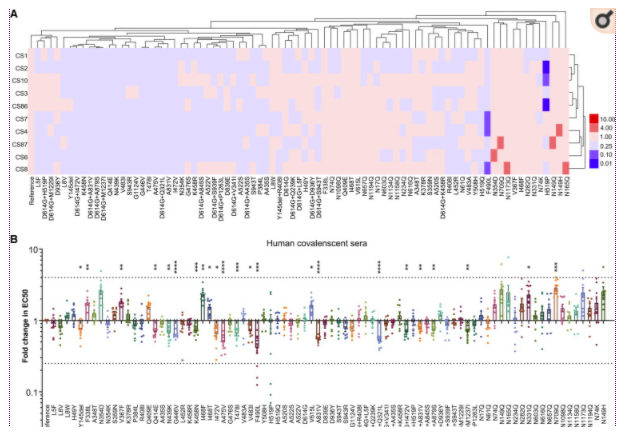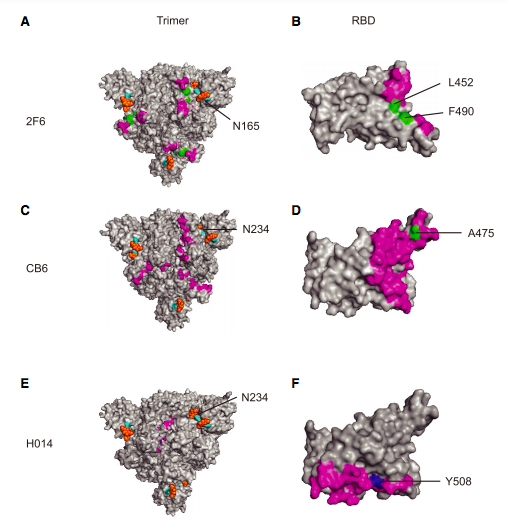BIOL368/S19 Week 11
- Weekly Assignments
- Individual Journal Entries
- Fatimah Alghanem Journal Entry Week 2
- Fatimah Alghanem Journal Entry Week 3
- Fatimah Alghanem Journal Entry Week 4
- Fatimah Alghanem Journal Entry Week 5
- Fatimah Alghanem Journal Entry Week 6
- Fatimah Alghanem Journal Entry Week 7
- DrugComboDB Review
- Fatimah Alghanem Journal Entry Week 9
- Fatimah Alghanem Journal Entry Week 10
- Fatimah Alghanem Journal Entry Week 11
- The Mutants Research Project Week 12
- Fatimah Alghanem Journal Entry Week 14
- Class Journal
BIOL368/F20 BIOL368/F20:People
Purpose
The purpose of this week's assignment is to be able to analyze published scientific articles and chose an appropriate one for further analysis. specifically, the intention is that we learn more about SARS-Cov2 through this exercise.
Searching the Scientific Literature Part 2: Evaluating Scientific Sources
- link to the abstract of the article on PubMed
- link to the full text of the article in PubMed Central:
- link to the full text of the article (HTML format) from the publisher website
- link to the full PDF version of the article from the publisher website
- Who owns the rights to the article: 2020 Elsevier Inc.
- How is the article available to you:
- Is the article available “open access”
- no this article is not available for open access.
- If the article is not “open access” is it available for free after a certain period of time has elapsed? You would not find the words “open access” or the “unlocked” icon, but you would still be able to access the article. If YES, stop here
- No, the article is not available for free after a certain period of time has elapsed.
- Did LMU buy a subscription or pay a fee for your access to this article? You might see “Loyola Marymount University” or “LMU” on the article website. Alternately, a list of the journals that LMU pays for can be found at: http://sq4ya5rf2q.search.serialssolutions.com/ If YES, stop here:
- yes LMU is subscribed to free access to this article.
- Is the article available “open access”
- Is the article available online-only or both in print and online? Look on the journal website for a “subscription” link. If that page talks about subscribing to the print edition, then it is available in print. If not, it is available online-only.
- This article is available in print and online.
Evaluating the source--the journal
- Who is the publisher of the journal?
- the publisher of the journal is Elsevier Incorporated.
- Is the publisher for-profit or non-profit?
- The publisher is for-profit.
- Is the publisher a scientific society (some scientific societies partner with a for-profit publisher, some act as their own non-profit publisher)
- The publisher is not a scientific society and is not a partner with one.
- Does the publisher belong to the Open Access Publishers Association?
- The publisher does not belong to the Open Access Publishers Association
- What country is the journal published in?
- The country that the journal was published in is Amsterdam, Netherlands.
- How long has the journal been in operation? (e.g., browse the archive for the earliest article published)
- The journal been in operation since 1974.
- Are articles in this journal peer-reviewed?
- Some of the Articles in the journal are peer-reviewed.
- Provide a link to the scientific advisory board/editorial board of the journal.
What is the journal impact factor (look to see if it is provided on the journal home page; often you can also find it through a Google search)#?
- 3.339
Evaluating The source--The article
- Is the article a review or primary research article?
- Primary Research Article
- On what date was the article submitted?
- June 8, 2020
- On what date was the article accepted?
- July 10, 2020
- Did the article undergo any revisions before acceptance?
- Yes the article was revised before acceptance.
- When was the article published?
- July 17, 2020
- What is the approximate elapsed time between submission and publication?
- One month.
- What are the institutions with which the authors are affiliated?
- the Division of HIV/AIDS and Sex-Transmitted Virus Vaccines
- Institute for Biological Product Control
- National Institutes for Food and Drug Control (NIFDC)
- WHO Collaborating Center for Standardization and Evaluation of Biologicals, No. 31 Huatuo Street, Daxing District, Beijing 102629, China.
- Graduate School of Peking Union Medical College, No. 9 Dongdan Santiao, Dongcheng District, Beijing 100730, China
- Have the authors published other articles on this subject? (How will you find this out?)
- yes the author published other articles [1]
- Is there a conflict of interest for any of the authors?
- No there's no conflict of interest for any of the authors.
- Make a recommendation--based just on the information you have gathered so far, is this a good article to evaluate further? Why or why not?
- Based on the information I gathered so far, I believe that the article is good. The article includes a lot of data that lead to the conclusion.
Preparation for Journal Club 2
Biological Terms Definitions
- Trimers: a polymer formed from three molecules of a monomer (Biology Online 2020)
- Epitope: any immunological determinant group of an antigen (Cammack 2008)
- positive-strand RNA: Viruses of classes IV and VI that have a single-stranded RNA *genome that can act as mRNA and is itself infectious (Lackie 2009).
- VeroE6: A specific line of Vero cells (Lackie 2007)
- Neutralize:to render neutral (def. 1, 2) or ineffective; to counteract(Cammack 2008)
- RLU: Relative Light Unit, a measurement of bioluminescence. (Berthold 2020)
- Hemagglutinin: A substance that causes hemagglutination (Biology Online 2020)
- Polyclonal: an antibody that arises from the immune response to an immunogen (Cammack 2008)
- Glycosylation: A biochemical process where a glycan attaches to a protein, a lipid, or another organic molecule (Biology Online 2020)
- Monoclonal antibody: an immunoglobulin secreted by a single clone of antibody‐producing cells, either in vivo or in culture (Cammack 2006)
Article Outline
- What is the importance or significance of this work?
- The importance of this work is that the study looks into a mutation at N-linked glycosylation sites that could possibly cause infectivity to SARS-Cov-2 or what's known as COVID-19. Since COVID-19 is a pandemic that has been affecting the world and resulted in many deaths and influenced the economy as well, it's important to look into ways that would either prevent it from the transmission of it to people or limit the effectivity of it in order to eliminate its danger. Therefore, this paper is significant as it looks into ways to limit viral infectivity and Antigenicity.
- What were the limitations of previous studies that led them to perform this work?
- although previous studies looked into mutations in SARS-Cov-2, other studies are limited in that they did not look in-depth into N-linked glycosylation sites. Especially that other studies did not have as much information regarding SARS-Cov2 as they were conducted early in the pandemic.
- How did they overcome these limitations?
- They overcome these limitations by generating 106s mutants; 80 varients and 26 glycosylation sites in which there were analyzed for how they reacted to neutralizing antibodies.
- What is the main result presented in this paper? (Hint: look at the last sentence of the introduction and restate it in plain English.)
- The main result presented in this paper is that mutation tested in the study was in fact effective in reducing activity and antigenicity of COVID-19.
- What were the methods used in the study?
- all S sequences reported in GISAID database were retrieved, and then alignment analyses were conducted on sequences of the S protein were. Then three groups of variants and mutants were selected to construct the pseudotyped viruses from using Wuhan-1 strain as a template.
- Briefly state the result shown in each of the figures and tables that you have been assigned in your group.
- Figure 5:

- Figure 5 shows:
- Increase in neutralization activity in N165Q, N149H, N149Q, N1173Q, N709Q, N354D
- Major decrease in neutralization activity in H519P
- decrease in neutralization activity in F490L
- F338L, V367F, I468F, I468T, and V615L were even more sensitive to the convalescent sera compared with reference strain
- more variants were found to be resistant to the convalescent sera including single and double amino Acid Change
- Figure 6:

- Figure 6 shows:
- A475V, L452R became resistant to some neutralizing antibodies
- N165Q became more sensitive
- N234Q was markedly resistant to neutralizing antibodies.
- F490L became resistant to some neutralizing antibodies
- Figure 5:
- What are the important implications of this work?
- The important implications of this work is that it showed how different antibodies interact with SARS-Cov2 and it gives hope to the usefulness of those antibodies. Also it showed how SARS-Cov2 mutates which would help in figuring out how to treat it by inactivating it.
- What future directions should the authors take?
- Future directions that the authors should take is that since they identified the areas of variations ins SARS-Cov2 and the activity of amino acids in SARS-cov2 they should go on to find ways to mutate strains that are active as that would lead to possibly weakening the virus affect in patients.
- Give a critical evaluation of how well you think the authors supported their conclusions with the data they showed. Are there any limitations or major flaws to the paper?
- I think that the authors gave a sufficient amount of data to support their conclusion. However, they failed to explain their data clearly which made it confusing to understand the results they had.
Powerpoint Presentation
Scientific Conclusion
In this lab, we practiced critically reading a scientific journal article and analyzing it. From the article, we learned about possible ways to inactivate SARS-Cov2. We also created a group presentation for our chosen article to present what we learned from analyzing the results of the article and how it contributes to the scientific community.
Acknowledgments
- I acknowledge my partners Yaniv Maddahi Macie Duran and JT Correy for working with me on our presentation and in choosing an article for our journal club.
- I acknowledge Dr. Dahlquist for helping me and my partners choose an article that's appropriate for this assignment
- Except for what is noted above, this individual journal entry was completed by me and not copied from another source.
Falghane (talk) 06:19, 19 November 2020 (PST)
References
- Li, Q., Wu, J., Nie, J., Zhang, L., Hao, H., Liu, S., . . . Wang, Y. (2020). The Impact of Mutations in SARS-CoV-2 Spike on Viral Infectivity and Antigenicity. Cell, 182(5). doi:10.1016/j.cell.2020.07.012
- OpenWetWare. (2020). BIOL368/F20:Week 11. Retrieved 19 November 2020, from https://openwetware.org/wiki/BIOL368/F20:Week_11.
- Oxford Dictionary of Biochemistry and Molecular Biology, by Richard Cammack et al.
- The Dictionary of Cell and Molecular Biology, by J. M. Lackie.